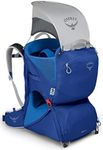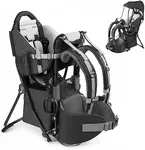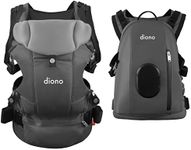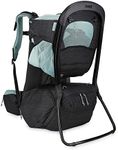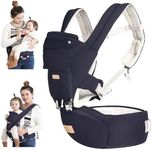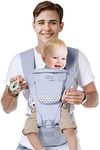Buying Guide for the Best Baby Hiking Carriers
Choosing a baby hiking carrier is all about finding the right balance between comfort, safety, and practicality for both you and your child. Since you'll be carrying your baby for extended periods, it's important to consider how the carrier fits your body, how secure and comfortable your child will be, and what features will make your hiking experience enjoyable. Think about the types of hikes you plan to do, the age and size of your child, and how often you'll use the carrier. By understanding the key features, you can make a choice that keeps both you and your little one happy on the trail.Weight CapacityWeight capacity refers to the maximum weight the carrier can safely hold, including your child and any gear you might store in the carrier. This is important because exceeding the limit can compromise safety and comfort. Carriers typically fall into ranges such as up to 30 pounds (for infants and smaller toddlers), 30-40 pounds (for most toddlers), and 40+ pounds (for older toddlers or when carrying extra gear). To pick the right one, consider your child's current weight and how much they are likely to grow during the time you plan to use the carrier. If you want the carrier to last through several growth stages, choose one with a higher weight capacity.
Fit and AdjustabilityFit and adjustability describe how well the carrier can be tailored to your body and your child's size. This is crucial for comfort, especially on longer hikes. Some carriers offer basic adjustments, while others have multiple straps and settings for torso length, shoulder width, and hip belt size. If more than one adult will use the carrier, or if you have a unique body shape, look for a model with a wide range of adjustments. Try to test the fit if possible, or check for detailed sizing guides to ensure it will be comfortable for you.
Child Comfort and Safety FeaturesThis includes padded seats, harness systems, and head or neck support for your child. These features keep your child secure and comfortable, which is especially important for longer outings. Some carriers have simple seat designs, while others offer adjustable seats, stirrups for leg support, and sunshades. If your child is very young or will be napping in the carrier, look for extra padding and good head support. For older, more active children, adjustable seats and harnesses can help keep them comfortable as they grow.
Storage OptionsStorage options refer to the pockets, compartments, and pouches built into the carrier for carrying essentials like diapers, snacks, water, and extra clothing. Some carriers have minimal storage, while others offer large compartments and multiple pockets. If you plan to go on longer hikes or want to carry all your supplies in one place, look for a carrier with ample storage. For short walks or if you prefer to use a separate backpack, a simpler carrier may be sufficient.
Weight and Bulk of the CarrierThe weight and bulk of the carrier itself can affect how easy it is to carry and transport. Lighter carriers are easier to handle and pack, but may have fewer features or less padding. Heavier carriers often offer more comfort and storage but can be tiring to carry over long distances. Think about your own strength and endurance, as well as how far you plan to hike. If you’ll be doing short, easy walks, a lighter carrier may be best. For longer or more challenging hikes, a sturdier, more supportive carrier might be worth the extra weight.
Ventilation and Weather ProtectionVentilation and weather protection features help keep both you and your child comfortable in different conditions. Some carriers have mesh panels for airflow, while others include sunshades, rain covers, or wind shields. If you’ll be hiking in hot or variable weather, look for good ventilation and included weather protection. For mostly indoor or mild-weather use, these features may be less important.

